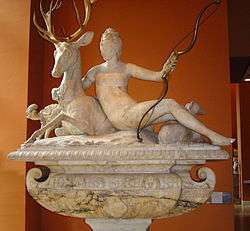Fountain of Diana

Fountain of Diana (Diane d'Anet, Diana with a Stag), c. 1549, is a marble Mannerist sculpture of Diane de Poitiers as goddess Diana in the Louvre (Louvre MR 1581 MR sup 123). Formerly known as Jean Goujon's work, it is now thought more likely to have been the work of Germain Pilon[1] or someone else (see below).
Description
The goddess of hunting Diana is represented with two dogs (a greyhound and a barbet dog named Phrocyon and Cyrius) and with a big stag. This silhouette is one of the symbols of the French Renaissance. It isn't the true portrait of Diane de Poitiers but one of the many images of moon goddesses closely related (paintings "Diana the Huntress" by a School of Fontainebleau, "Le Bain de Diane" by François Clouet, etc.)[2]
This sculpture was a part of the fountain in Diane de Poitiers's Château d'Anet built by Philibert de L'Orme. It was heavily restored twice in 18th century, second time in 1799-1800 by Pierre-Nicolas Beauvallet.[2]
The traditional attribution to Jean Goujon is not accepted today. It was suggested by Alexandre Lenoir in 18th century. Among the other versions of the authorship - Benvenuto Cellini, Pierre Bontemps, Ponce Jacquiot and especially Germain Pilon.
Bibliography
- Mayer M., "La fontaine de Diane du château d'Anet n'est pas de Benvenuto Cellini", Revue de l'Art, no. 68, 1935, pp. 125-134.
- Du Colombier P., Jean Goujon, Paris, 1949, pp. 130-133.
- Blunt A., Art et architecture en France 1500-1700, Paris, 1983 (English edition, 1953), p. 108.
- Michèle Beaulieu, Description raisonnée des sculptures du Musée du Louvre, vol. 2, Renaissance française, Paris, 1978, pp. 96-99.
- Zerner H., L'Art de la Renaissance en France. L'invention du classicisme, Paris, 1996, pp. 361-363.
See also
- Nymph of Fontainebleau
- School of Fontainebleau
References
- ↑ Blunt, Anthony; Beresford, Richard (1999). Art and Architecture in France, 1500–1700, 5th edition, pp. 80–81. New Haven, Connecticut: Yale University Press. ISBN 9780300077483
- 1 2 Fountain of Diana in Louvre